Using flax for foliage
25 February 2012Click here to visit an upgraded version of this blog post on my new website at alibrown.nz.
 Flax leaves are a popular and versatile addition to floral arrangements, irrespective of whether the flowers are picked from the garden or are woven from flax itself. Modern hybrid flaxes come in a variety of different colourings and are often used by florists in commercial floral displays. Flax can be dried into long thin rods and used to give height to a display, it can be netted to give a lacy effect in a display or it can be woven to make a foliage design rather than a flower. It can also be shredded into long strips and used to add a sense of movement to a display.
Flax leaves are a popular and versatile addition to floral arrangements, irrespective of whether the flowers are picked from the garden or are woven from flax itself. Modern hybrid flaxes come in a variety of different colourings and are often used by florists in commercial floral displays. Flax can be dried into long thin rods and used to give height to a display, it can be netted to give a lacy effect in a display or it can be woven to make a foliage design rather than a flower. It can also be shredded into long strips and used to add a sense of movement to a display.
Shredded flax adds a light and airy dimension. It’s simple, easy, takes very little time to prepare, and can add a variety of interesting shapes and movements to a display. The thin mid-rib piece of flax that is stripped off a leaf before weaving can be used for shredding. It’s ideal for this purpose as one end is the hard base of the leaf, which makes a strong stem. 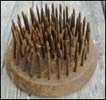 It’s also a way of using up pieces of flax that are usually seen as waste. Shred the flax with a strong dog comb or one of those spikey florist’s bases that is used in the bottom of vases to hold stalks in place.
It’s also a way of using up pieces of flax that are usually seen as waste. Shred the flax with a strong dog comb or one of those spikey florist’s bases that is used in the bottom of vases to hold stalks in place.
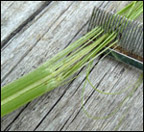
 Take the mid-rib piece and shred the flax from where the flax joins together down to the tip of the flax. Run the comb along the flax piece several times until it is evenly and reasonably finely shredded. This can be added to an arrangement as it is, or it can be dyed to give some colour and movement to an arrangement, as illustrated in the flax flower arrangement here.
Take the mid-rib piece and shred the flax from where the flax joins together down to the tip of the flax. Run the comb along the flax piece several times until it is evenly and reasonably finely shredded. This can be added to an arrangement as it is, or it can be dyed to give some colour and movement to an arrangement, as illustrated in the flax flower arrangement here.
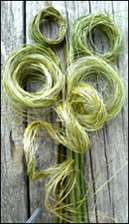
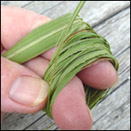 Another way of using shredded flax is as a tight circlet or as softer flowing curls, as illustrated in the bouquet at the top of this post. To make the tight circlet, smooth the shreds together so they become a smooth rope and then wrap them around your fingers so they make a ring.
Another way of using shredded flax is as a tight circlet or as softer flowing curls, as illustrated in the bouquet at the top of this post. To make the tight circlet, smooth the shreds together so they become a smooth rope and then wrap them around your fingers so they make a ring.  Keep wrapping until all of the flax rope is wrapped into the ring. Tie the ring of flax in place around the stem with a fine piece of flax to make a circlet or circlets for a display, or hold the wrapped circle in place with the tie or a peg until it dries and then it tease it out until it falls in soft ringlets or waves.
Keep wrapping until all of the flax rope is wrapped into the ring. Tie the ring of flax in place around the stem with a fine piece of flax to make a circlet or circlets for a display, or hold the wrapped circle in place with the tie or a peg until it dries and then it tease it out until it falls in soft ringlets or waves.
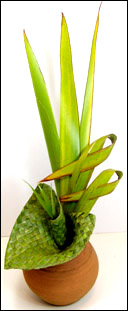 Florists often use the coloured variegated flax for foliage but green flax can be just as decorative.
Florists often use the coloured variegated flax for foliage but green flax can be just as decorative.  If it is featured as a straight leaf, it can give a strong structural quality to a display. By contrast, if it is curled around, it can give a soft, voluptuous quality. Flax foliage is particularly popular in Ikebana arrangements but it suits all kinds of displays. There are many ways flax can be used in floral arrangements, and some additional ideas on using flax as foliage can be found in my book. If you have any other ideas for using flax as foliage, do send me images of them to share on this blog post.
If it is featured as a straight leaf, it can give a strong structural quality to a display. By contrast, if it is curled around, it can give a soft, voluptuous quality. Flax foliage is particularly popular in Ikebana arrangements but it suits all kinds of displays. There are many ways flax can be used in floral arrangements, and some additional ideas on using flax as foliage can be found in my book. If you have any other ideas for using flax as foliage, do send me images of them to share on this blog post.
© Alison Marion Brown 2012.


April 16th, 2012 at 9:49 am
What a great idea, I have seen shredded flax curls used in flax bouquets in my mother in laws house, they give it a nice sense of softness and movement, thanks.
December 6th, 2012 at 5:37 pm
Hi Ali
I have only just heard about you, one of my friends is just learning about flax weaving, putiputi making etc. I was amazed with the information on your website that will be a lot of help for her.
I have given all the information that is required.
I will be buying a book for her and i very soon for a Christmas present. Thank you from my friend and I we are going to be having some fun.
December 6th, 2012 at 9:02 pm
Hi Toyah
It’s good that you have are finding the web site useful. I hope you have as much fun flax weaving as I do!
January 16th, 2013 at 1:01 pm
I live in Scotland and was wondering if your book Weaving Flowers from New Zealand Flax is still available and could be sent to me?
Thank you for your attention.
January 19th, 2013 at 9:51 am
Hello Maureen
Yes the book is available. I’ll send you a Paypal invoice for payment. The book will be dispatched promptly once I receive the payment.
You may also be interested in a booklet I have just produced called “Weaving a Large Container from New Zealand Flax”. The instructions for this will also be included in the book I am currently writing on weaving a basket, or kete, but as the writing of this book has been interrupted by the Canterbury earthquakes and family matters, I’ve put the booklet out in the meantime. If you’d like the booklet as well, let me know. It’s NZ$10.
January 23rd, 2013 at 2:20 pm
Kia ora Ali, i was just want to know if you have any instructions on how to weave a mini kete? a kete thats about 10 x 10cm .. i cant seem to find anything on the net and i cant make it to the library if u can help me.. that would b awesome
January 26th, 2013 at 11:01 am
Kia ora Hinewai
I don’t currently have any instructions available but I will do when my next book is published as they will be in that. The only suggestion I have is to ask someone else to go to the library for you, if possible, and get out the book Maori Weaving by Erenora Puketapu-Hetet.
February 2nd, 2013 at 9:30 am
Kia ora Ali,
Thank you for sharing your weaving skills, it’s very clear instructions is much appreciated from a new comer to weaving. I’d love to have a copy of your large container booklets, and also be added to your data base.
February 3rd, 2013 at 10:05 am
Kia ora Pixie
Thanks for your comments about my book. To buy the container booklet, please deposit NZ$13 into my Westpac bank account 03–0823–0516382–000 and email me your postal address. I’ll send the booklet promptly once payment is received.
February 11th, 2013 at 12:15 pm
Kia Ali
I am not sure if you are still going to do another book on weaving kete, your flower book I purchased has been awesome are you still going ahead with your next publication Thankyou for sharing your gifts.
Jan TeWAo
February 25th, 2013 at 9:01 am
Ali I was on one of your courses at the Waikawa marae and would like to know how you do the three cornered kono or waka, I have been trying to work the one corner out unable to do so.
Hope u can help
February 27th, 2013 at 6:55 pm
kia ora Terangi
Good to hear from you. In the three cornered waka, one corner is woven in the middle of one side of the base mat and the other two are woven at the corners. You need to weave the single corner by holding the mat up with the shiny side of the flax towards you, and weave the strips across from both sides as you hold it up, rather than weaving it while it is flat on the ground. Let me know how you get on.
March 4th, 2013 at 7:39 am
Hi Ali,
I have your Weaving Flowers from NZ Flax book, and have been doing a bit of practicing. I thought I prepared the leaf properly using a blunt knife, but when the flax dries, it shrinks quite a bit leaving big spaces in the piece which don’t look so good. Is there anything else I can do to prevent this? Many thanks, Marianne
March 6th, 2013 at 6:49 pm
Kia ora…do u have another book out after your first one u released on putiputi
March 6th, 2013 at 6:50 pm
sorry my email was wrong first send its cherrylhkora@gmail.com
arohamai
March 11th, 2013 at 7:57 am
Hello Marianne
There are two things that are responsible for the flax shrinking - how moist the flax is when you weave with it and the tension of your weaving.
If you are cutting the flax and weaving with it while it is green, it can be useful to soften the leaf and then let it dry a bit more for one to several hours before weaving it. If the flax is boiled then it may need to be left a bit longer to dry out more before you weave with it.
Tension when weaving is also important. Pull each piece firmly into place as you weave. Keep tensioning during the whole weaving process.
These two things should help to keep your weaving tight and even.
March 11th, 2013 at 7:59 am
Hi Shirley
I have just produced a booklet called “Weaving a Large Container from New Zealand Flax”. The instructions for this will also be included in the book I am currently writing on weaving a basket, or kete, but as the writing of this book has been interrupted by the Canterbury earthquakes and family matters, I’ve put the booklet out in the meantime. If you’d like the booklet, the cost is NZ$13 which includes postage and packaging. My bank account is Westpac bank account 03–0823–0516382–000.
April 30th, 2013 at 1:44 pm
Hi Ali
Received your book on Friday, made my first 2 flowers on Saturday (which I gave to hubbys daughter inlaw) and since Sunday I’ve made almost everything in your book.
I’m so thankful I found a (correspondent) teacher who put into words and pictures such an easy to follow technique of weaving with such beautiful results. I’m sure my little keepsakes are only going to get better over time with alot more practice, (although I don’t think that they’re at all bad at present).
Can’t wait for my wee girl to learn also, she sits beside me taking it all in and folding the leaves back up for me.
Thanks again Ali for bringing back into my life such an enjoyable and pleasant pastime.
Kind regards
Lynda
June 25th, 2013 at 11:40 pm
Hi Ali
Came across this book. Kete Whakairo (Plaiting Flax for Beginners) by Margaret Rose Ngawakka
Gives detailerd,step by step instructions and illustrations for plaiting a beginners version of this type of kete.
I find it easy to follow and I’m just a beginner.
Available in the libraries.
Regards Mei
June 29th, 2013 at 10:18 am
Hi Mei
Thanks for letting me know about this book. I have ordered it and will put it on my Reviews page when I’ve read it.
August 22nd, 2013 at 12:48 pm
can u please tell me how to dye harakeke yellow properly with teri dyes….ive boiled my flax an partially dryed then dyed in yellow but still comes out green yellow
August 24th, 2013 at 9:35 am
Hi Hine
I’ve found the yellow dye is quite difficult to get to a proper yellow although it’s been a while since I dyed flax yellow. To get a clear colour it is usually best to boil the flax, dry it and let it bleach in the sun, and then dye it the colour you want it to be.
Also it can take up to about ten days for the flax to dry properly and turn a proper yellow so you may find the colour gets better as the flax gets completely dry.
Have you contacted Ioulia Crowley who sells the dyes and asked her about the yellow? She may have some information about this.
August 27th, 2013 at 7:14 pm
ty vm for that info an tried it an yes ur right ….boil it an leave it a few days …awesonme to be able to ask questions tyvm
September 10th, 2014 at 2:33 pm
Tena Koe Ali,
Can you use any spray paint on harakeke?? I have only dye my flax with teri dye, but have seen in wedding photos that the harakeke can also be spray painted as well. How does the spray last on flax and how much damage will it cause to the flax??